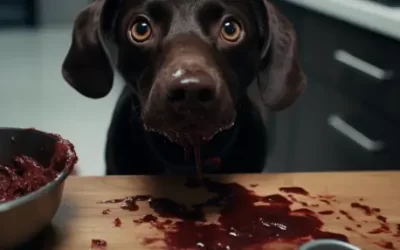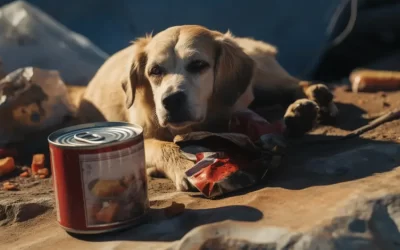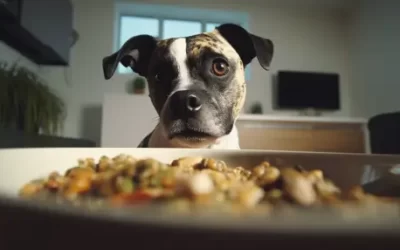Many dog owners often wonder about the safety of certain human foods for their furry companions. One common query that arises is Can Dogs Eat Grapes.
This question typically stems from a genuine concern for a pet’s well-being and a desire to ensure their diet is free from harmful substances. Understanding the risks associated with certain foods helps dog owners make informed choices and safeguard their pet’s health.
With years of experience and comprehensive knowledge in veterinary science and pet care, I can confidently address the concern surrounding dogs consuming grapes.
Throughout my professional career, I’ve encountered numerous cases and researched extensively on the topic, enabling me to provide accurate information and guidance to pet owners.
This expertise positions me to offer valuable insights into the potential dangers grapes pose to dogs and the recommended course of action to keep our canine friends safe.
If you’re seeking clarity on whether dogs can safely consume grapes, this article will provide you with a definitive answer.
I’ll delve into the reasons behind the toxicity of grapes for dogs, the potential health risks associated with their consumption, and steps to take if your pet ingests this fruit accidentally.
By reading further, you’ll gain actionable advice and a better understanding of how to protect your dog from potential hazards, ensuring their well-being remains a top priority.
Dogs should not eat grapes as they can be toxic and lead to severe kidney damage or failure. Even small amounts can be harmful. Symptoms include vomiting, lethargy, and abdominal pain. If a dog consumes grapes, seek immediate veterinary attention.
- The Grape Debate Are Grapes Safe for Dogs?
- Recognizing the Signs of Grape Toxicity in Dogs
- Factors Influencing Grape Toxicity in Dogs
- Potential Health Risks
- Tips for Preventing Grape Consumption
- Alternatives to Grapes: Safe and Healthy Treats for Dogs
- What to Do If Your Dog Eats Grapes Emergency Actions
- Final Thoughts: Can Dogs Eat Grape?
- Frequently Asked Questions on Feeding Dogs Grape
- What Grapes Can Dogs Eat?
The Grape Debate Are Grapes Safe for Dogs?

Grapes, often enjoyed as a healthy snack by humans, have sparked a considerable debate within the veterinary community regarding their safety for our canine companions.
Let me guide you through the intricacies of this grape debate, shedding light on the potential risks and concerns associated with dogs consuming grapes.
Toxicity Concerns Associated with Grapes
Grapes, though seemingly harmless to humans, pose a significant threat to our four-legged friends. The perplexity lies in the fact that the exact cause of grape toxicity in dogs remains elusive.
While research is ongoing, various cases have linked grape consumption to severe health issues in canines, particularly in the renal system. It’s crucial for pet owners to recognize the gravity of the situation and exercise caution when it comes to sharing grapes with their furry companions.
Specific Substances in Grapes that May be Harmful to Dogs
The burstiness of the grape debate arises from the mystery surrounding the toxic components in grapes for dogs.
Current understanding suggests that substances such as resveratrol, present in the skin of grapes, and potentially other yet-to-be-identified compounds, may trigger adverse reactions in canine physiology.
The lack of a clear culprit heightens the caution veterinarians advise when it comes to allowing dogs access to any form of grapes, be it raw, dried, or processed.
Various Grape Products and Their Potential Impact on Dogs
The debate extends beyond fresh grapes to encompass various grape-derived products like raisins and grape juice. In my years of veterinary practice, I’ve encountered cases where seemingly innocent treats, like raisins, have led to severe health complications in dogs.
The concentrated nature of raisins and grape juice can escalate the risk of toxicity, underscoring the need for pet owners to be vigilant about ingredients in both homemade and commercially available pet treats.
Recognizing the Signs of Grape Toxicity in Dogs

As a vigilant pet owner, understanding the signs of grape toxicity in dogs is paramount to ensuring the well-being of your furry friend.
In this section, we’ll delve into the subtle indicators that may hint at grape ingestion and discuss the urgency surrounding seeking immediate veterinary attention. Real-life examples will underscore the importance of swift action in the face of grape toxicity.
Symptoms of Grape Toxicity in Dogs
The perplexity of grape toxicity lies in its varied and sometimes delayed symptoms. Dogs affected by grape ingestion may exhibit signs such as vomiting, diarrhea, lethargy, and abdominal pain.
More advanced cases may involve symptoms like decreased urine production and, in severe instances, kidney failure.
The severity of these symptoms demands keen observation by pet owners, as prompt recognition can be the key to mitigating potential long-term health consequences for their beloved companions.
Importance of Immediate Veterinary Attention if Toxicity is Suspected
In the case of a potential grape toxicity scenario, time is of the essence. If you observe any symptoms or suspect your dog has ingested grapes, it is crucial to seek veterinary attention without delay.
The expertise of a veterinarian is essential for a proper diagnosis, timely intervention, and the initiation of appropriate treatments. The authority of veterinary professionals in these situations cannot be overstated, as they possess the knowledge and resources to address grape toxicity comprehensively.
Factors Influencing Grape Toxicity in Dogs

Grape toxicity in dogs is a nuanced topic, influenced by various factors that contribute to the perplexity surrounding its effects.
In this section, we’ll explore the degree of sensitivity to grapes, delving into how size, breed, individual differences, age, and pre-existing health conditions can play pivotal roles in determining the potential risks for our canine companions.
Size and Breed Variations in Sensitivity to Grapes
The burstiness of sensitivity to grapes among dogs is notably influenced by their size and breed. Smaller breeds and certain specific breeds exhibit a heightened sensitivity to the toxic components in grapes.
The perplexity arises from the fact that what may cause minimal effects in a larger breed could be potentially devastating for a smaller or more susceptible breed.
This size and breed-dependent burstiness necessitates a tailored approach in assessing the risks associated with grape consumption in different dogs.
Individual Dog Differences in Processing Toxins
Just as humans exhibit individual variations in how their bodies process certain substances, so do dogs. The burstiness of individual responses to grape toxins means that one dog may show severe symptoms while another, seemingly unscathed, may have ingested a similar amount.
Factors such as metabolism, genetics, and overall health contribute to their toxin resistance. Pet owners should recognize the importance of understanding their dog’s unique traits and how they may influence the processing of toxins, including those found in grapes.
Role of Age and Pre-existing Health Conditions
The perplexity deepens when considering the role of age and pre-existing health conditions in grape toxicity. Puppies and senior dogs, as well as those with underlying health issues, may be more vulnerable to the adverse effects of grape consumption.
The burstiness of their physiological responses, influenced by developmental stages or compromised health, underscores the need for tailored care and attention.
Recognizing the potential impact of age and existing health conditions on the burstiness of grape toxicity is essential for pet owners aiming to provide optimal care for their dogs.
Potential Health Risks

Understanding the potential health risks associated with dogs consuming grapes is crucial for responsible pet ownership.
In this section, we’ll delve into the burstiness of health implications, exploring the intricate details of kidney failure, gastrointestinal issues, and the long-term consequences that may arise from grape ingestion.
Kidney Failure
The perplexity surrounding the link between grape consumption and kidney failure in dogs has been a focal point of veterinary research. The burstiness of this potential health risk lies in the fact that not all dogs react the same way to grapes, but for some, it can lead to severe renal complications.
The substances within grapes, yet to be fully identified, seem to have a specific impact on the kidneys, potentially causing irreversible damage.
Recognizing the signs of kidney failure, such as increased thirst, lethargy, and decreased urine production, is crucial for pet owners to ensure prompt veterinary intervention, minimizing the risk of long-term health consequences.
Gastrointestinal Issues
The burstiness of gastrointestinal issues resulting from grape consumption in dogs is another facet of concern for pet owners.
Vomiting and diarrhea are common early symptoms, reflecting the body’s attempt to expel the ingested toxins. However, the severity can escalate, leading to dehydration and electrolyte imbalances.
The perplexity arises as the burstiness of symptoms can vary, and what might seem like a mild reaction could potentially progress to more severe complications. This reinforces the importance of immediate veterinary attention to address gastrointestinal issues and prevent further health risks.
Long-term Implications
Beyond the immediate burstiness of symptoms, grape ingestion can have long-term implications for a dog’s health. Even if the initial reaction appears mild, there may be latent effects on the kidneys or other organs that can manifest over time.
The perplexity of these long-term implications underscores the need for vigilant monitoring, regular veterinary check-ups, and a proactive approach to maintaining the overall well-being of the canine companion.
Pet owners should be aware that even a seemingly insignificant encounter with grapes can have consequences that extend beyond the immediate timeframe.
Tips for Preventing Grape Consumption

Prevention is the cornerstone of responsible pet ownership when it comes to the potential risks associated with dogs consuming grapes.
In this section, we’ll explore actionable tips to minimize the perplexity of grape exposure, emphasizing the importance of educating household members, proper food storage, and implementing training and behavioral practices.
Educating Household Members
The burstiness of grape toxicity risks can be significantly reduced by ensuring that everyone in the household is well-informed about the potential dangers grapes pose to dogs. A comprehensive understanding of what foods contain grapes and the potential consequences of ingestion is essential.
Educating family members, especially children who may be inclined to share snacks with the family dog, creates a shared responsibility for the well-being of the furry family member. This burstiness in awareness can be a crucial factor in preventing accidental grape consumption and fostering a safe environment for the canine companion.
Proper Food Storage
Minimizing the risk of grape exposure begins with proper food storage practices. Grapes and grape-containing products should be stored securely, out of reach of inquisitive paws. This burstiness in storage precautions extends to ensuring that trash bins containing grape remnants are inaccessible to dogs.
Pet owners should adopt a proactive approach, recognizing the potential danger even in seemingly harmless scenarios, such as discarded grape stems or raisin-laden baked goods.
By implementing proper food storage practices, pet owners can reduce the risk of accidental grape ingestion and its associated health complications.
Training and Behavioral Practices
The perplexity of preventing grape consumption is further addressed through training and behavioral practices. Dogs can be trained to understand and respond to commands that discourage them from approaching or consuming forbidden foods. Consistent reinforcement of these commands creates a burstiness in their behavioral patterns, reducing the likelihood of them seeking out or accepting grapes.
Additionally, positive reinforcement for desirable behaviors, coupled with the burstiness of consistent training, establishes a foundation for a safe and healthy coexistence between dogs and their human companions.
Alternatives to Grapes: Safe and Healthy Treats for Dogs

While grapes pose a potential risk to our canine companions, there exists a burstiness of alternative treats that are not only safe but also contribute to their overall health and happiness.
In this section, we’ll explore the variety of fruits, vegetables, and creative treat options that pet owners can consider, emphasizing the importance of moderation in treat-giving for optimal well-being.
Listing Fruits and Vegetables that are Safe for Canine Consumption
Navigating the landscape of safe treats begins with a burstiness of knowledge about fruits and vegetables that dogs can enjoy without the associated risks. Apples, blueberries, carrots, and watermelon are just a few examples of the burstiness of canine-friendly options.
Understanding the specific nutritional benefits of each and incorporating them into the dog’s diet adds both variety and healthful elements to their treats. This burstiness in knowledge empowers pet owners to make informed choices, providing a diverse range of safe alternatives to grapes.
Creative and Nutritious Treat Options for Dogs
Beyond the burstiness of traditional fruits and vegetables, pet owners can explore creative and nutritious treat options that cater to their dog’s preferences. Homemade treats using ingredients like peanut butter, pumpkin, or yogurt can add a burstiness of flavor and nutritional value.
The perplexity lies in the versatility of these options, allowing pet owners to tailor treats to their dog’s taste while ensuring they remain free from potentially harmful substances. This burstiness of creativity in treat selection enhances the overall quality of the dog’s diet.
Importance of Moderation in Treat-Giving
The perplexity of providing alternatives to grapes comes with a burstiness of responsibility—moderation in treat-giving is key. While these alternatives are safe, an excess of treats can lead to nutritional imbalances and potential health issues.
It is crucial for pet owners to understand the burstiness of appropriate portion sizes and integrate treats into the dog’s overall diet in a balanced manner. This burstiness in moderation ensures that treats complement, rather than compromise, the dog’s health and well-being.
What to Do If Your Dog Eats Grapes Emergency Actions

Discovering that your dog has consumed grapes can be a perplexing and concerning situation for any pet owner. In this section, we’ll explore the burstiness of emergency actions, providing guidance on immediate steps to take, the importance of contacting a veterinarian without delay, and an overview of potential treatments and interventions that can make a crucial difference in mitigating the risks associated with grape ingestion.
Immediate Steps to Take If a Dog Consumes Grapes
In the burstiness of a grape ingestion incident, prompt action is essential. If you suspect or witness your dog consuming grapes, the first immediate step is to induce vomiting. Administering hydrogen peroxide as directed by your veterinarian can help expel the grapes from your dog’s system.
However, it’s crucial to note that this burstiness in the initial response should be guided by professional advice, as inducing vomiting may not be appropriate in all situations.
The perplexity of individual cases demands a tailored approach, highlighting the necessity of consulting with a veterinarian as quickly as possible.
Importance of Contacting a Veterinarian Right Away
The burstiness of contacting a veterinarian right away cannot be overstated. Immediate professional advice is vital to assess the potential risks, determine the appropriate course of action, and initiate timely interventions.
Veterinarians possess the authority and expertise to guide pet owners through the perplexity of grape toxicity, offering personalized recommendations based on the size, breed, and health status of the affected dog.
Delay in seeking veterinary attention can significantly impact the burstiness of the outcome, underscoring the critical importance of swift action.
Overview of Potential Treatments and Interventions
Once veterinary contact has been established, the burstiness of potential treatments and interventions comes into focus.
Depending on the severity of the grape ingestion and the dog’s individual response, treatments may include intravenous fluids, activated charcoal administration to limit absorption, and monitoring of kidney function.
The perplexity of these potential interventions highlights the need for professional assessment, as each case may require a tailored approach. Veterinarians will guide pet owners through the burstiness of post-ingestion care, ensuring the best possible outcome for the canine companion.
Final Thoughts: Can Dogs Eat Grape?

Dogs should not eat grapes. Grapes and raisins can pose a serious threat to canine health, potentially leading to kidney failure, gastrointestinal issues, and other complications.
The burstiness of the toxic substances within grapes, as well as the individual variability in dogs’ reactions, makes it imperative for pet owners to avoid exposing their canine companions to any form of grapes, be it fresh, dried, or in processed products.
In the veterinary field, there is a consensus on the potential risks associated with grape consumption in dogs, emphasizing the importance of responsible pet ownership and creating awareness to prevent accidental ingestion and its potential adverse effects.
In this comprehensive discussion, we’ve dissected the burstiness of grape toxicity in dogs, exploring the potential risks, emergency actions, safe alternatives, and the veterinary perspective.
Key points include the dangers associated with grape ingestion, the varied symptoms of toxicity, and the burstiness of factors influencing the severity of these risks.
The importance of recognizing signs early, seeking immediate veterinary attention, and understanding the burstiness of preventative measures has been highlighted.
Pet owners are urged to remember the potential health risks, the necessity of informed choices, and the burstiness of responsible pet ownership practices.
The perplexity of responsible pet ownership shines through as a recurring theme. The burstiness of feeding practices, preventative measures, and emergency actions all underscore the role pet owners play in safeguarding their dogs from potential harm.
The awareness of what constitutes safe treats, the burstiness of proper food storage, and the necessity of moderation in treat-giving collectively contribute to responsible pet ownership.
In a burstiness of love for our canine companions, it is our duty to prioritize their health and well-being in every aspect of their care.
In the spirit of a burstiness of community, readers are encouraged to share the insights gained from this discussion with other dog owners. The burstiness of information-sharing contributes to a collective effort in ensuring the safety and health of all canine companions.
By disseminating knowledge about the risks associated with grapes and promoting responsible pet ownership practices, readers can play an active role in fostering a burstiness of awareness within their communities.
Frequently Asked Questions on Feeding Dogs Grape
Can dogs eat grapes in any quantity without harm?
Are certain types of grapes safer for dogs to eat?
What if my dog accidentally ate a grape? What should I do?
Can dogs eat other grape products like raisins or grape juice?
Is there a safe amount of grapes that dogs can eat?
What Grapes Can Dogs Eat?
Can Dogs Eat Grape Leaves?
Can Dogs Eat Muscadine Grapes?
Can Dogs Eat Grape Stems?
Can Dogs Eat Grape Popsicles?









